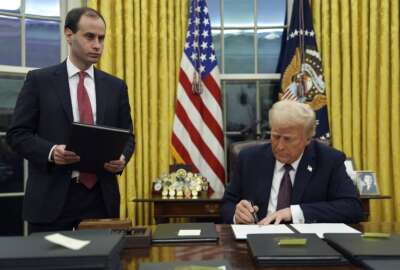Recruiting, retention key to bucking federal retirement trends
A reverse retirement wave is challenging chief human capital officers to rethink how they plan their workforce in FY 2020 and beyond. Two agencies -- one large, one...
wfedstaff | June 4, 2015 8:04 pm
By Sean McCalley
Federal News Radio
When planning an agency workforce five to 10 years in advance, a manager faces two major obstacles. The first is a popular trend among older employees to forego the opportunity to retire, creating a “reverse” retirement wave; the second is a trend among millennial employees to only work for the federal government a few years before leaving the public sector.
Whether it’s a large agency like the Homeland Security Department (with more than 225,000 employees), or a medium-sized one like the Nuclear Regulatory Commission (with about 3,600 employees), planning a workforce for year 2020 and beyond focuses on a singular concept: Hire and develop an agile workforce that is flexible enough to handle a variety of mission-critical programs and activities. Since what constitutes as “mission critical” changes over time, that process relies heavily on skill development to give employees the professional tools they need to tackle fresh challenges as they surface.
Because it’s sometimes hard to teach an old dog new tricks, an aging workforce creates a unique set of circumstances that places more pressure on agencies to retain younger employees. But right now, the median length of service for employees born after 1980 is 3.8 years, according to the Office of Personnel Management.
DHS and the NRC are exceptions to that trend.
“We’re doing a fairly good job with our millennials,” said Catherine Emerson, the DHS chief human capital officer in a panel discussion for our special report, The Reverse Retirement Wave. “Our workforce is over 20 percent millennial, so we’re higher than the rest of the government, and we haven’t really seen them leaving.”
The same success in recruitment and retention is happening at NRC, too. “Our retention level for entry level professionals is close to 90 percent,” said Miriam Cohen, NRC’s chief human capital officer. “For a lot of the technical folks that come in, it’s extremely high [too].”
The secret to staying young
For the NRC, the effort to retain new and young employees begins at the very start of their new career.
“We have a very robust entry-level training program,” Cohen said. “People get that training, they get deployed into our regional and headquarter offices, and are very capable and very motivated. If they do well, they get to move up very quickly in the organization.”
But the NRC has certain advantages that many other agencies don’t, like its reputation as a good place to start a career. In the latest Best Places to Work survey from the Partnership for Public Service, it ranked sixth out of 25 mid-sized agencies, which Cohen said was a down year. NRC also offers unique and attractive technical positions that not every agency needs or has funding for.
DHS, on the other hand, sees success despite many factors working against it. It ranks dead last in the large-agency category in the BPW survey, and members of Congress recently kicked it around as a political football in congressional budget negotiations. So much so, it pushed the agency to the brink of a complete shutdown. The secret to retaining younger employees, Emerson said, is a combination of the types of jobs it offers, and how it markets its mission.
“Our law enforcement positions, [millennials] tend to come and stay in those positions,” she said. “But we’re a really large agency, so we have a lot of opportunities for folks to stay and move around the different components.”
Where DHS wants to see better retention is in its cybersecurity workforce, as it plays a critical role in the agency’s workforce plans for 2020 and beyond. For that, the agency is focusing hard on ambushing new employees with a positive experience after hiring them. But the nature of the field, Emerson said, typically leads to employees that only stay for a few years before leaving the federal workforce.
“We’re not hiring them with the expectation or the requirement that they stay 20 to 30 years,” she said. “We certainly want them to come and have a very positive experience, work on some high-level assignments, and perhaps go out into the private sector and tell others about the wonderful work they had an opportunity to do here at DHS.”
Knowing how to plan for the 2020 workforce
For DHS, knowing how to build 5- and 10-year plans for structuring the workforce requires a blend of data analytics and collaboration among its component agencies.
“We have councils set up where we work with our components to evaluate their skill sets,” Emerson said. Regarding data analytics, “We look at competency models, we look at our attrition rates, which are actually pretty good compared to the rest of the government, [and] we look at our retirement numbers.”
The end result, she said, is a portrait of where the agency’s workforce strengths and weaknesses stand today, and what sort of path they’re headed on in the future. The trick is figuring out ways to alter that path, and redirect so it complements what the agency believes will be mission-critical priorities five to 10 years down the line. But it all starts with self awareness, so agencies like the NRC can identify what makes them unique and turn that into a powerful recruiting and retainment tool.
“On one hand, we have people that come here and stay because they absolutely love it, so the question is how can we ensure they have the careers that they need?” Cohen said. “A more interesting tidbit for me, looking at the workforce and where it’s going, is we also seem to be an attractive candidate for what I call ‘mid-career’ employees who have worked in the industry and that have come into the government because of quality of life issues.”
She said many of those people are former power plant employees, who agree to take on at least a 90-minute commute to and from work, in order to escape the drudgery of shift duties. Cohen believes agency recruiters should focus on interweaving a marketing campaign about how the federal government can offer tremendous work-life balance opportunities.
A fluid pipeline of incoming and outgoing employees is central to any long- term workforce plan, Emerson said, adding that many agencies are focused on increasing “employee engagement” as a retention method. But sometimes, the best solution is the simplest:
“Just saying ‘Thank you,’ and letting people know they’re valued, will go a long way in determining if someone’s ready to move on to another job,” she said.
MORE FROM THE SPECIAL REPORT, THE REVERSE RETIREMENT WAVE:
Part 1: Feds choose to stay longer, creating new retirement bubble
Part 2: Rehired annuitants help bridge agency skills gaps, but are they enough?
Part 3: Mentoring helps young feds answer the question, ‘What’s next?’
Part 4: Feds ride the money, benefits wave longer than expected
Part 6: Military-style personnel system could smooth path to next-generation workforce
Part 7: Six signs of hope for the federal workforce of the future
Commentary: Time to start planning new retirement reality
Copyright © 2025 Federal News Network. All rights reserved. This website is not intended for users located within the European Economic Area.





